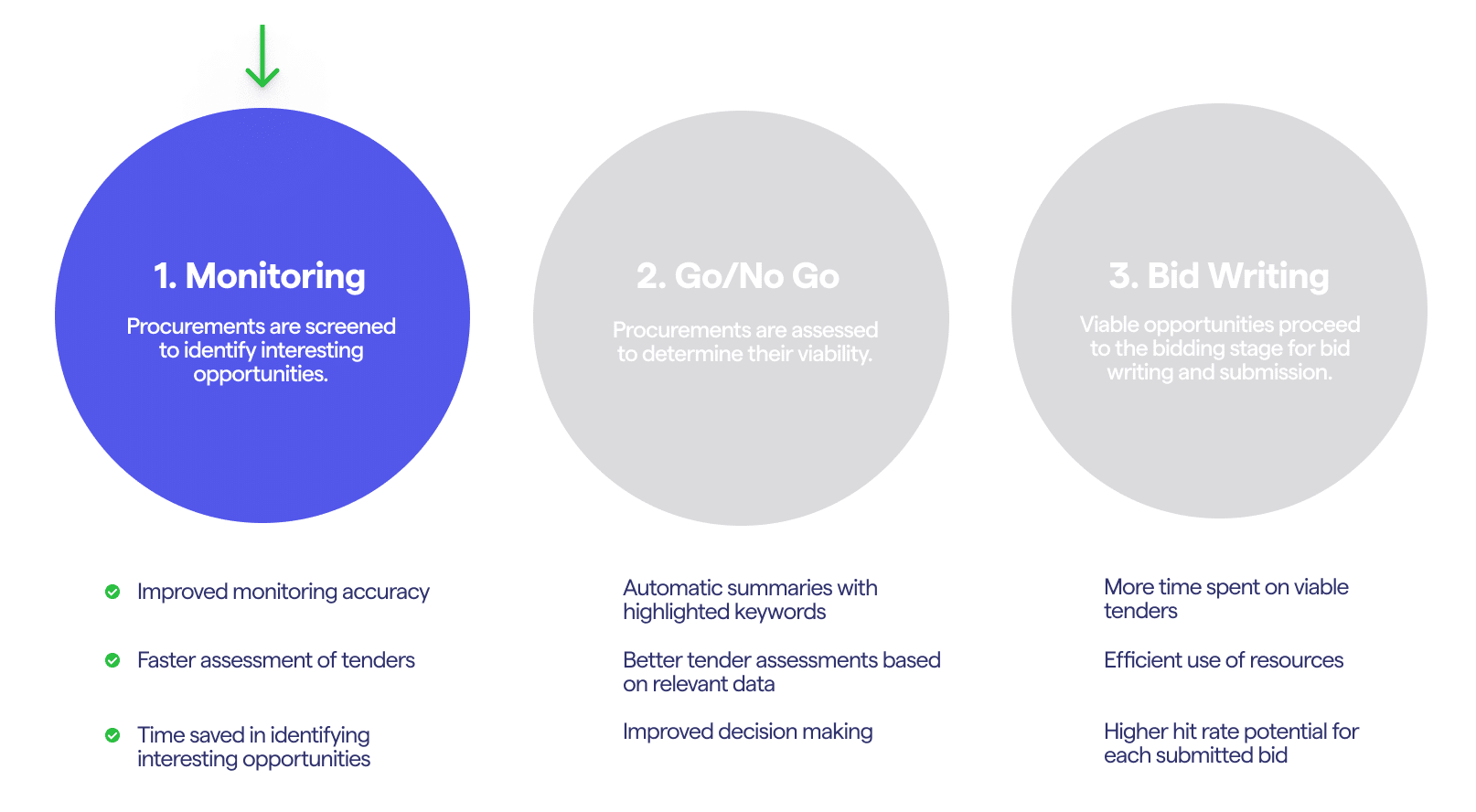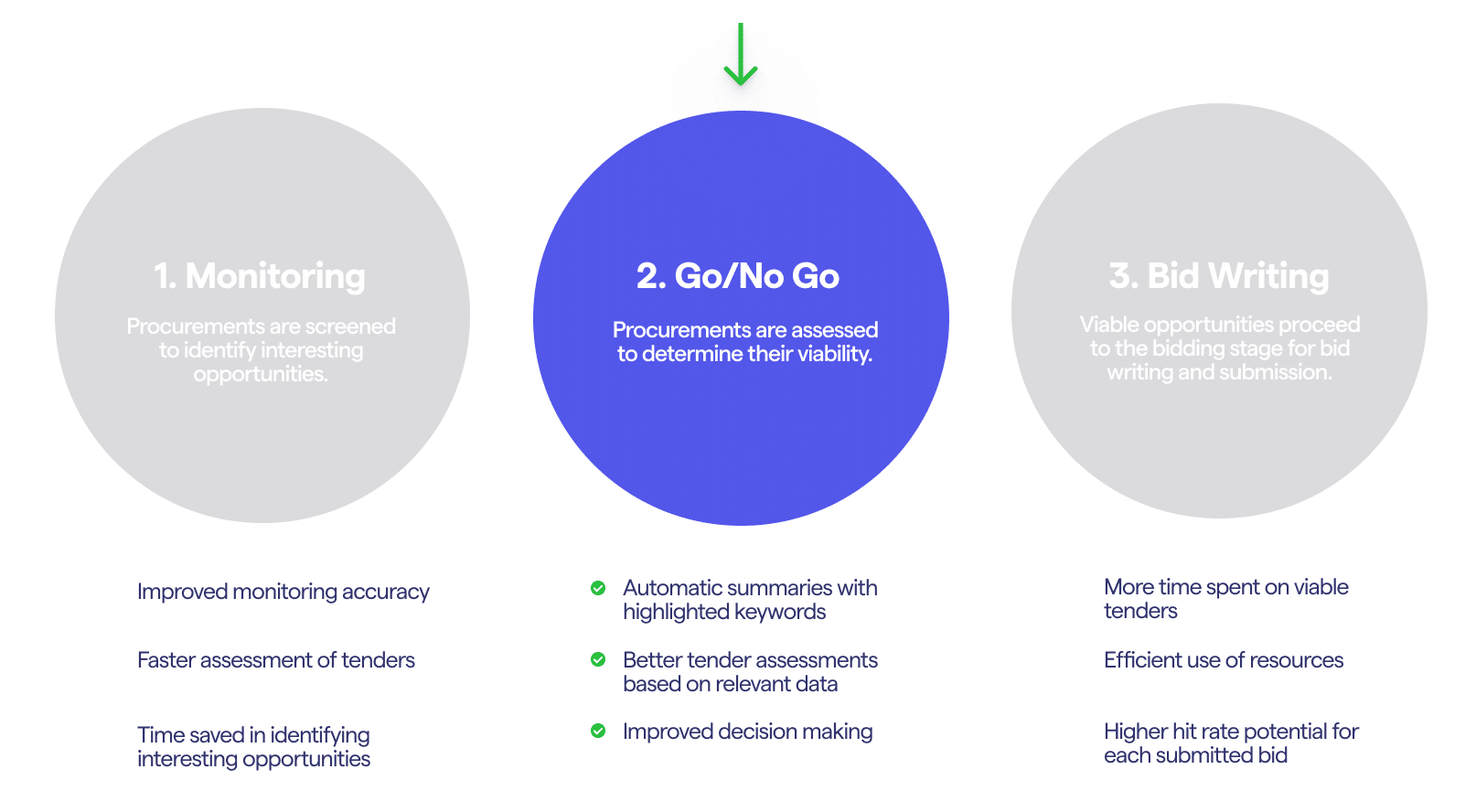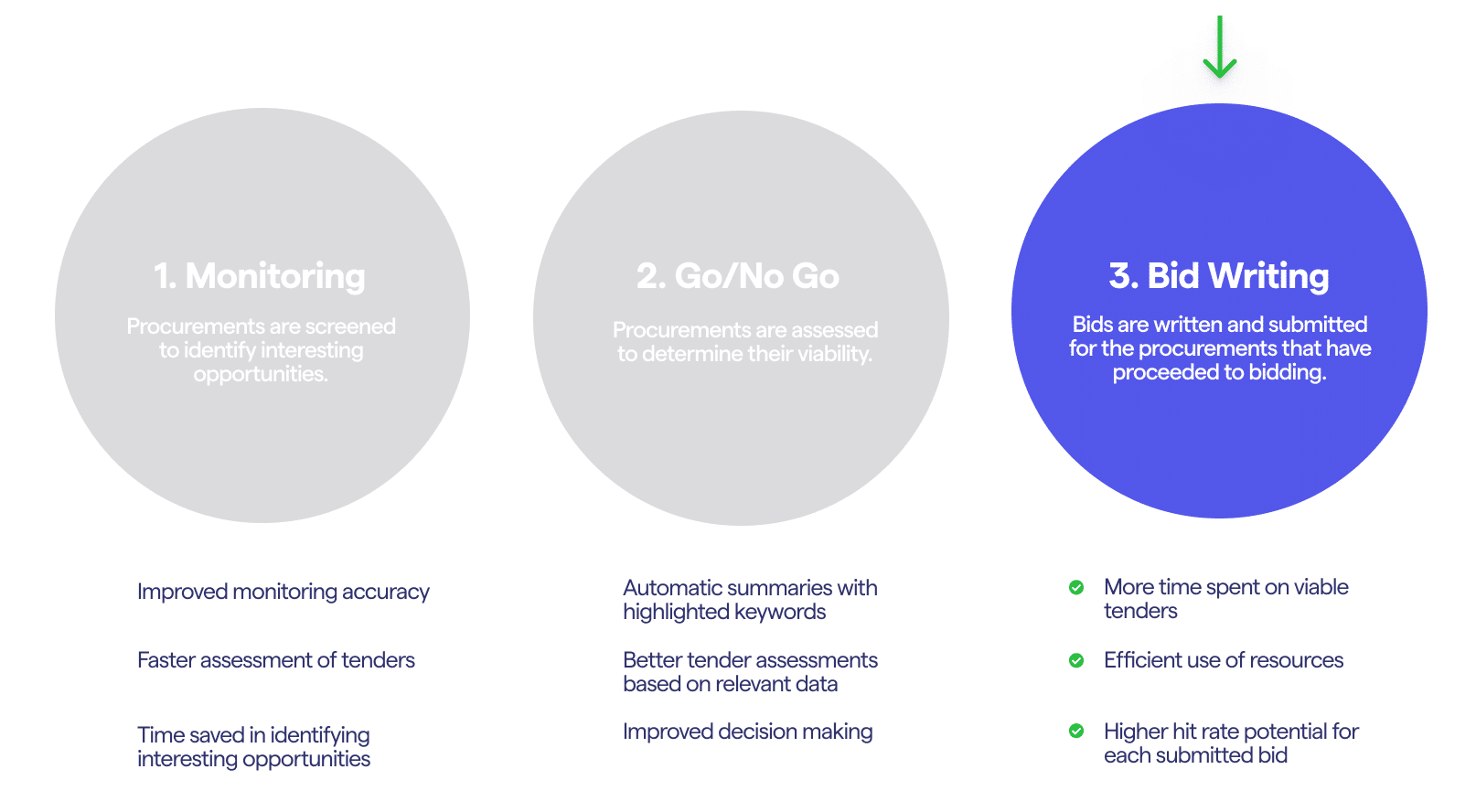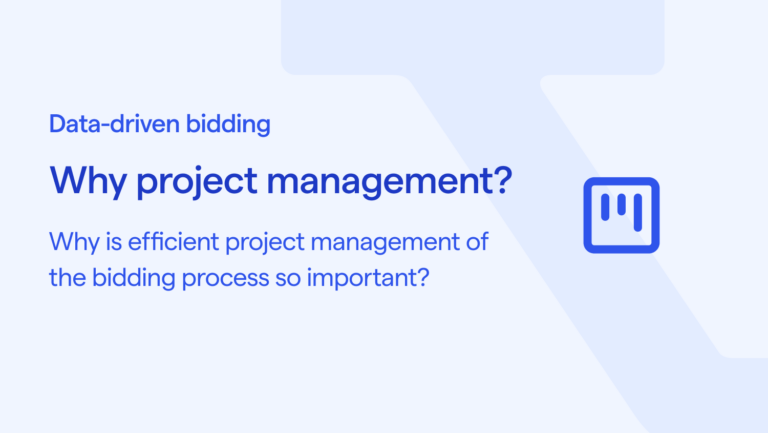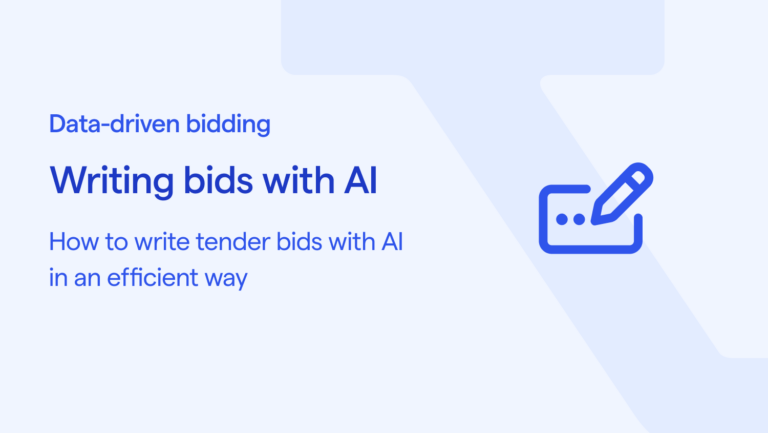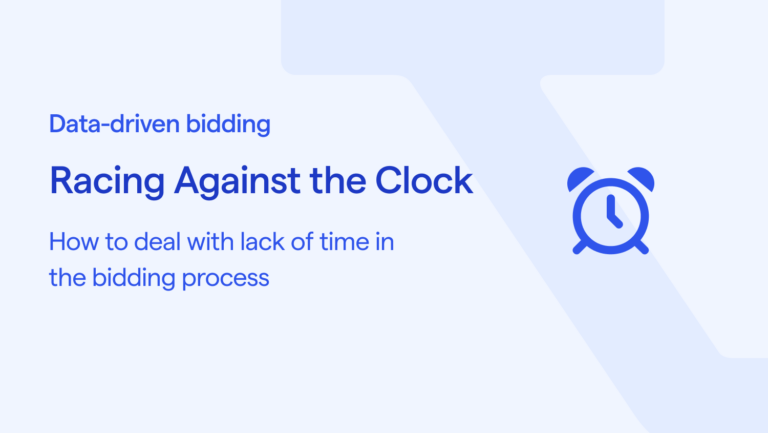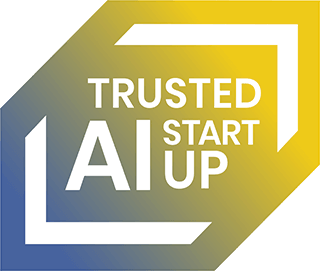Deciding whether or not to proceed with a bid is one of the most decisive steps in any bidding process. At Tendium, we think of this as the Go/No-Go phase, and we strongly believe that a data-driven approach improves not only efficiency but also the chances of securing a win. While many bidding teams have well-oiled and proven bidding processes in place, we believe that these can still be bettered by ensuring that existing practices are grounded in a data-driven approach.
In this article, we deep-dive into the benefits of how a data-driven approach can streamline and improve bidding processes, and how it is instrumental in ensuring that bidding teams make well-informed decisions in the Go/No-Go phase.
What is data-driven tendering?
Engaging in a data-driven approach means using relevant data to make fact-based and proactive decisions. Many bidding teams might feel that this is already a routine process, a rather self-evident and obvious method that is already incorporated into existing processes and workflows. After all, deciding whether or not to submit a bid is typically not something that a bidding team would consult a horoscope or truth sayer on.
While this is true, and bidding teams do review procurement documents and requirements, the question is: How available and accessible is this data, and can this be improved?
Why yes of course it can!
By leveraging our AI-based analytical tools, Tendium’s services ensure that relevant data is never far from hand or out of reach. Our AI analyses extract qualification requirements and applicable procurement information from tender documents, presenting this in a pedagogical and searchable manner. Facilitating quick and seamless access to procurement information thus enables a data-driven approach – but what are some of the key advantages?
1. Identifying relevant procurements faster
One of the most crucial aspects when working with procurements is locating relevant tender opportunities. The majority of bidding teams will likely be using a procurement monitoring service to locate and retrieve relevant tender opportunities, and one or more colleagues will be busy keeping an eye out if something interesting crops up. While this could be thought of as standard practice, consider how much time it takes to determine if interesting tender opportunities are indeed relevant.
Traditional monitoring services are usually fairly broad, and while filters and keywords can be used to quickly sort and distinguish tender opportunities from one another, most still require you to manually download and read procurement documents. For suppliers to the more niche industry sectors, this might not present a major hurdle, but for those bidding within an industry sector where a vast number of opportunities are published near-daily, the process can quickly become time-consuming.
With our data-driven approach and AI-based analytical tools, our service confidently improves the accuracy and efficiency of procurement monitoring. Our platform allows you to create a monitoring process that includes a set of custom parameters that go beyond those offered by traditional services. One key example of this is Document Keyword Searches, which are applied to the contents of procurement documents themselves, rather than being limited to a procurement notice, title or short description. These keywords could for instance be specific qualification requirements that are crucial to you in determining the viability of a tender opportunity.
Consider the following example: You and your bidding team know that certain qualification requirements crucially determine whether or not a potential tender opportunity is viable. In each instance where you locate a potential opportunity, your team downloads and reviews the related documents manually in order to confirm if the tender is viable.
But imagine if you could avoid the need to download and read each procurement document in the initial assessment stage. With our platform, you would be able to turn specific qualification requirements into custom keyword parameters, and our Automatic Summaries would present and highlight any passage or text where a specific keyword is identified. A far more streamlined and efficient process of finding relevant procurement opportunities compared to engaging in manual reviews.
2. Better data – better decisions
Having made an initial assessment, most bidding teams would traditionally meet to discuss relevant opportunities, to arrive at a more definitive Go/No-Go decision. These meetings might for instance include conversations on the scope, value and requirements of one or more tender opportunities, and most often, someone has spent time compiling this presentation. Alternatively, meeting participants might be asked to review procurement documents ahead of time, which could mean that multiple team members are required to review the same information – a rather inefficient and time-consuming process.
However, with Tendium’s data-driven approach, decision-makers during these internal assessment meetings have a better and more solid understanding of the details relating to potential opportunities. Equally, your entire team will save time, as the automatic summaries provide a clear overview of the potential opportunities where any specific keywords or information is immediately identifiable and highlighted.
Don’t believe us? According to our customers, our data-driven approach not only enhances their understanding and better prepares them for taking a Go/No-Go decision, it also allows them to make better-informed decisions, and ultimately, saves time.
3. Less wasted time on irrelevant business opportunities
In traditional bidding team processes, there is a significant amount of time that risks being wasted if, at a later stage, a tender opportunity that is being worked on turns out to be a poor fit or is otherwise found to be unviable. Often, several people may have already spent a considerable amount of time reviewing and compiling information. It is therefore crucially important that bidding teams can distinguish if opportunities are relevant or not in the quickest way possible.
By engaging in a data-driven approach, the relevant information is readily available early on in the assessment process, and bidding teams can easily identify blockers or requirements that would ultimately result in a No-Go decision. With an improved means of making definitive Go/No-Go decisions early on, you can reduce the number of unviable and irrelevant tender opportunities that might otherwise slip through unnoticed. This in turn both saves time and resources, improving your chances of winning relevant and viable opportunities.
4. Learning and transparency within the organisation
Using a data-driven approach when engaging in bidding processes improves efficiency, but it also has wider beneficial effects, and it allows for a deeper understanding and analysis of your bidding processes overall. It is likely that your bidding processes will include several different stages, but would it not be advantageous to be able to review at what stage opportunities are determined as a Go or No-Go?
Our platform allows you to save promising opportunities within what we call Bid Spaces – a type of notice board where all potential opportunities can be stored. From the Bid Spaces, your team can access and review each opportunity’s automatic summary, and progress the opportunity through the different stages of your bidding process. In addition, the Bid Spaces allow you to record further meta-data for each opportunity. This allows you to monitor progress all the way through until a tender bid is either submitted or the opportunity is rejected.
By utilising the Bid Space workflow and monitoring the progress of each opportunity, you can identify at what stages you most often reject an opportunity, and why. Is too much time being spent on unviable opportunities? If so, how come they are allowed to slip through your initial assessments? The Bid Space workflow and custom meta-data will thus allow you to gain insights and streamline your overall Go/No-Go decision-making process.
Another benefit of having a shared overview of your team’s current engagements is that it is easier to account for and react when colleagues or resources are absent. Equally, it assists bid managers in having a better understanding of multiple opportunities worked on simultaneously.
…
To summarise briefly, a data-driven approach promotes objective and proactive decisions in the Go/No-Go stage, saves time, and allows you to review each stage of your bidding workflow in more detail. Ultimately, the aim of any bidding team should be to save as much time as possible, in order to secure as many wins as possible – and the Tendium platform is here to ensure that this actually happens!

